Sensor Sweep: Robert E. Howard, J. R.R. Tolkien, H. P. Lovecraft, D&D
Monday , 28, August 2023 Sensor Sweep Leave a commentScience Fiction (Fantasy Literature): Conquerors From the Darkness first saw the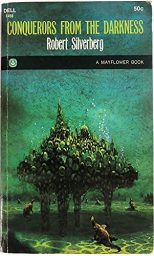 light of day as a $3.50 Holt, Rinehart and Winston hardcover in 1965, with a cover by Alan E. Cober. The novel was an expansion of Silverberg’s novella “Spawn of the Deadly Sea,” which had appeared in the April 1957 issue of Science Fiction Adventures magazine; a novella that I have not read.
light of day as a $3.50 Holt, Rinehart and Winston hardcover in 1965, with a cover by Alan E. Cober. The novel was an expansion of Silverberg’s novella “Spawn of the Deadly Sea,” which had appeared in the April 1957 issue of Science Fiction Adventures magazine; a novella that I have not read.
 Tolkien (Black Gate): J.R.R Tolkien’s 1937 children’s fantasy The Hobbit is one of the most beloved books in the world, and because it serves (according to the cover of my old Ballantine paperback) as the “enchanting prelude to the Lord of the Rings” it is also one of the most influential books of the last century, all of which means that those who would presume to adapt the story for other media would be wise to tread warily.
Tolkien (Black Gate): J.R.R Tolkien’s 1937 children’s fantasy The Hobbit is one of the most beloved books in the world, and because it serves (according to the cover of my old Ballantine paperback) as the “enchanting prelude to the Lord of the Rings” it is also one of the most influential books of the last century, all of which means that those who would presume to adapt the story for other media would be wise to tread warily.
Crime Fiction (M Porcius): I recently purchased a copy of the big Fredric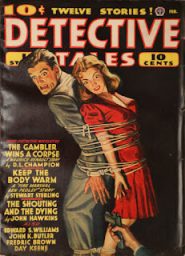 Brown anthology put out in 2012 by Bruin Crimeworks, Miss Darkness, and from the “Tinglers” section late last month I read four stories first printed in the 1940s. There are four more stories under the “Tinglers” heading, one of which we read in July 2022 when we read a bunch of critically-acclaimed noir stories, “Don’t Look Behind You.” Let’s read the other three today, one from the World War II era, two from the early Sixties.
Brown anthology put out in 2012 by Bruin Crimeworks, Miss Darkness, and from the “Tinglers” section late last month I read four stories first printed in the 1940s. There are four more stories under the “Tinglers” heading, one of which we read in July 2022 when we read a bunch of critically-acclaimed noir stories, “Don’t Look Behind You.” Let’s read the other three today, one from the World War II era, two from the early Sixties.
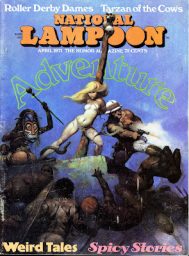 Humor (Porpor Books): Let’s take a trip back in time again, to April, 1971, and the latest issue of National Lampoon, which features a fine cover by Frank Frazetta. There’s some interesting advertising in the magazine.
Humor (Porpor Books): Let’s take a trip back in time again, to April, 1971, and the latest issue of National Lampoon, which features a fine cover by Frank Frazetta. There’s some interesting advertising in the magazine.
Comic Books (Tentaclii): The Illustrated History of Warren Magazines is now available in a new “revised and expanded” edition, with the original being Illustrators Special No. 14, which lists on Amazon UK as “The Illustrated History of Warren Comics”.
Robert E. Howard (Ken Lizzi): Dennis Dorgan, the character whose exploits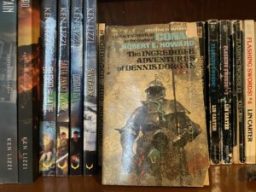 are collected in The Incredible Adventures of Dennis Dorgan, is definitely not Popeye the Sailor Man, despite his creation shortly after the release of E.C. Segar’s classic character in 1929. Dennis makes this perfectly clear by his stated dislike of canned spinach. Though both men are sailors, speak in distinctive jargon, and frequently engage in fisticuffs, Dorgan is in fact derived from another sailor: Sailor Steve Costigan, Howard’s other pugilistic seaman.
are collected in The Incredible Adventures of Dennis Dorgan, is definitely not Popeye the Sailor Man, despite his creation shortly after the release of E.C. Segar’s classic character in 1929. Dennis makes this perfectly clear by his stated dislike of canned spinach. Though both men are sailors, speak in distinctive jargon, and frequently engage in fisticuffs, Dorgan is in fact derived from another sailor: Sailor Steve Costigan, Howard’s other pugilistic seaman.
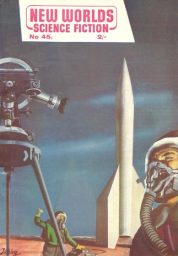 Science Fiction (SFF Remembrance): Today we’ll be talking about a very early but very interesting Brunner story with “Fair,” while the second installment of The Stone That Never Came Down will be replaced with another Brunner short story that’s been on my radar, “The Totally Rich.”
Science Fiction (SFF Remembrance): Today we’ll be talking about a very early but very interesting Brunner story with “Fair,” while the second installment of The Stone That Never Came Down will be replaced with another Brunner short story that’s been on my radar, “The Totally Rich.”
History (Sagas From the Sea): On a clear day I stood on the shore of the Blackwater estuary in Essex. Across a tidal causeway was Northey Island, and sheltered in the inner estuary was the town of Maldon. It was here, on the 11th August 991, that Maldon earned its place in history. The Battle of Maldon saw the destruction of the East Anglian fyrd (local levies raised in time of need) and the death of its leader, Earl Byrhtnoth, Ealdorman of East Anglia, at the hands of a Viking army.
Strange Stuff (Ancient Origins): A giant 4,000-year-old Bronze Age pyramidical structure with links to a horse cult has been uncovered in the ochre-tinted earthen steppes of Kazakhstan. The culmination of almost a decade of research and excavation, this large-scale steppe pyramid in Kazakhstan—which dates back to the 2nd millennium BC—languished in relative obscurity for countless centuries. Nothing like it has ever been discovered in the Central Asian steppes, making it an especially exciting find.
pyramidical structure with links to a horse cult has been uncovered in the ochre-tinted earthen steppes of Kazakhstan. The culmination of almost a decade of research and excavation, this large-scale steppe pyramid in Kazakhstan—which dates back to the 2nd millennium BC—languished in relative obscurity for countless centuries. Nothing like it has ever been discovered in the Central Asian steppes, making it an especially exciting find.
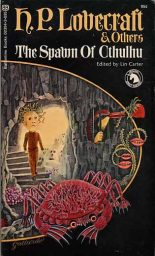 Robert E. Howard (Sprague de Camp Fan): “The Children of the Night” was first published in Weird Tales, April/May 1931. It has been reprinted several times. It was included in Bran Mak Morn: The Last King, Ballantine (Del Rey) Books, 2005 since it features REH’s version of the Picts.
Robert E. Howard (Sprague de Camp Fan): “The Children of the Night” was first published in Weird Tales, April/May 1931. It has been reprinted several times. It was included in Bran Mak Morn: The Last King, Ballantine (Del Rey) Books, 2005 since it features REH’s version of the Picts.
D&D (Humble Bumble): Get ready to put your players through the meat grinder with this gargantuan collection of modules and supplements for the Dungeon Crawl Classics RPG system from Goodman Games! This bundle includes 70+ DCC books, ranging from essential modules like Idylls of the Rat King, The Lost Vault of Tsathzar Rho, and The Mysterious Tower, to mammoth supplements like Castle Whiterock, a veritable campaign-in-a-virtual-box.
collection of modules and supplements for the Dungeon Crawl Classics RPG system from Goodman Games! This bundle includes 70+ DCC books, ranging from essential modules like Idylls of the Rat King, The Lost Vault of Tsathzar Rho, and The Mysterious Tower, to mammoth supplements like Castle Whiterock, a veritable campaign-in-a-virtual-box.
Spy Fiction (Spy Guys and Gals): Quiller is an agent for The Bureau. The first line of action known about Quiller was the time spent during the latter months of the war behind enemy lines, masquerading as a German soldier assigned to several concentration camps, working in reality to free as many of the condemned Jews as he could. When the war was over and his activities made known, he was offered medals from several countries for his bravery but rejected them all out of frustration for not having saved more.
Review (Silver Key): Hanuvar has lost it all—his land, his people, and his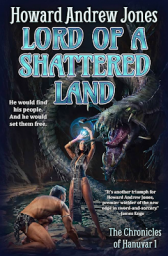 family—following a disastrous military defeat. Narrowly escaping his own death and presumed dead by his enemies, the exiled former General vows to find the scattered remnants of his surviving people and set them free. And kick some ass along the way.
family—following a disastrous military defeat. Narrowly escaping his own death and presumed dead by his enemies, the exiled former General vows to find the scattered remnants of his surviving people and set them free. And kick some ass along the way.
Audio (Horror Babble): “The Cairn on the Headland” is a short story by the American author, Robert E. Howard. First appearing in Strange Tales of Mystery and Terror in its January 1933 edition, the story tells of a troubled historian, who discovers an ancient, shunned cairn on the outskirts of Dublin.
Cinema (Black Gate): The Black Cauldron, an animated feature from Disney,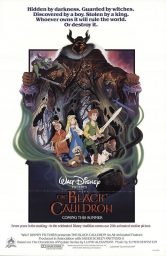 was released on July 24th in 1985. It was one of a number of films I consulted on for the studio. At the time, it was purported to be the most expensive animated film ever made (though cheap by today’s standards). It had quite a turbulent history and almost killed off Disney animation entirely.
was released on July 24th in 1985. It was one of a number of films I consulted on for the studio. At the time, it was purported to be the most expensive animated film ever made (though cheap by today’s standards). It had quite a turbulent history and almost killed off Disney animation entirely.
Fantasy (Dark Worlds Quarterly): “The Seal of Zaon Sathla” by Lin Carter was first published in Carter’s anthology, The Magic of Atlantis (1970). Now Lin wrote many stories in his career but this one is more intriguing to me than most.The plot follows Tirion the Glad Magician as he goes to the magicians’ annual fair to buy magical items.
Comic Books (Paperback Warrior): William Dubay (1948-2010) was an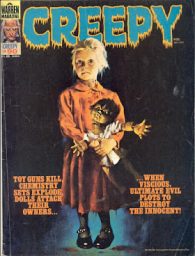 editor, writer, and artist for Warren Publishing, excelling on books like Creepy, Vampirella, 1984, and Eerie. Later in his career, he wrote a story for Heavy Metal, became an editor of Archie Comics and edited titles for Western Publishing. Fitting for Warren Publishing, Dubay’s writing had some seriously dark overtones, evident in the memorable, disturbing story “Please…Save the Children”, which was drawn by Martin Salvador and featured in the July 1977 issue of Creepy.
editor, writer, and artist for Warren Publishing, excelling on books like Creepy, Vampirella, 1984, and Eerie. Later in his career, he wrote a story for Heavy Metal, became an editor of Archie Comics and edited titles for Western Publishing. Fitting for Warren Publishing, Dubay’s writing had some seriously dark overtones, evident in the memorable, disturbing story “Please…Save the Children”, which was drawn by Martin Salvador and featured in the July 1977 issue of Creepy.
Tolkien (Master Samwise): In the first episode of the Stories that Really Matter, I gush over the Ride of the Rohirrim from Return of the King. This scene is incredibly inspiring and beautiful, and brings tears to my eyes every time I watch it.
RPG (Ten Foot Pole): The civilization that once worshipped the Baboon King 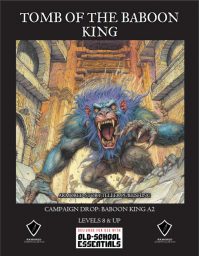 no longer exists, and only a few scattered ruins remain. None remember its name. A few rare scholars and priests deciphered fragments of the ancient city- state’s history. The humidity of the region devoured most scrolls and painted images left behind. Only the stories recorded in worn stone provided a clue into the past.
no longer exists, and only a few scattered ruins remain. None remember its name. A few rare scholars and priests deciphered fragments of the ancient city- state’s history. The humidity of the region devoured most scrolls and painted images left behind. Only the stories recorded in worn stone provided a clue into the past.
Tolkien (Judeo Christ): Military Blunders of Lord of the Rings – Vox Day
Lovecraft (Tentaclii): This week my regular ‘Picture Postals from Lovecraft’ post visits Dunwich. Or rather, visits “The Dunwich Horror” country in the form of the region around Wilbraham, Mass. Lovecraft visited here for eight days, and the terrain and atmosphere inspired one of the best-loved horror tales of the 20th century.
Science Fiction (Fantasy Literature): In his 1953 novel The Kraken Wakes, English author John Wyndham gave his readers a tale concerning aliens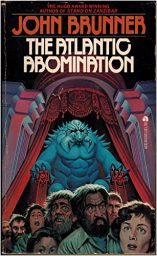 who land on Earth and proceed to terrorize the planet from their bases on the ocean floor. But this, of course, was not the last time that a British writer would regale his readers with a story about malevolent space visitors living beneath the seas. Thus, in John Brunner’s novel of seven years later, The Atlantic Abomination, we find another set of hideous and destructive underwater dwellers, but unlike the ”xenobathetic, millebrachiate pseudocoelenterates” in Wyndam’s book, Brunner’s are a whole different kettle of fish – or something – as will be seen.
who land on Earth and proceed to terrorize the planet from their bases on the ocean floor. But this, of course, was not the last time that a British writer would regale his readers with a story about malevolent space visitors living beneath the seas. Thus, in John Brunner’s novel of seven years later, The Atlantic Abomination, we find another set of hideous and destructive underwater dwellers, but unlike the ”xenobathetic, millebrachiate pseudocoelenterates” in Wyndam’s book, Brunner’s are a whole different kettle of fish – or something – as will be seen.
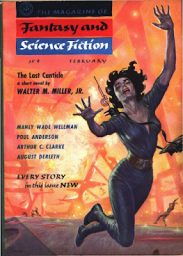 Science Fiction (M Porcius): Let’s crack open the February 1957 issue of F&SF to finish up Arthur C. Clarke’s 1956 collection of anecdotes about the human race’s first trip to the Moon, as related by the captain of the British component of the joint US-UK-USSR expedition, “Venture to the Moon.”
Science Fiction (M Porcius): Let’s crack open the February 1957 issue of F&SF to finish up Arthur C. Clarke’s 1956 collection of anecdotes about the human race’s first trip to the Moon, as related by the captain of the British component of the joint US-UK-USSR expedition, “Venture to the Moon.”
 Review (Mostly Old Books): Zero Cool, first published in 1969, is another of Michael Crichton’s early John Lange novels. This was reprinted by Hard Case Crime initially under the John Lange pseudonym. Its cool x-ray looking cover is shown with this review. (The original Signet paperback from 1969 has a lame photo cover). Hard Case later editions have Michael Crichton’s name in large letters on top with a “writing as John Lange” by line below in much smaller letters.
Review (Mostly Old Books): Zero Cool, first published in 1969, is another of Michael Crichton’s early John Lange novels. This was reprinted by Hard Case Crime initially under the John Lange pseudonym. Its cool x-ray looking cover is shown with this review. (The original Signet paperback from 1969 has a lame photo cover). Hard Case later editions have Michael Crichton’s name in large letters on top with a “writing as John Lange” by line below in much smaller letters.
Mythopoetic (Pulp Fiction Renaissance): If you have been reading writings,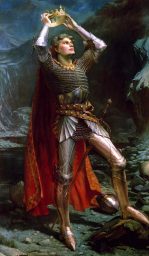 then you know that the Mythology of King Arthur and the Knights of the Round Table is very important to me. I believe strongly that for me, it is the foundation of the Indo-European Warrior Caste Mythology in its Northwest European varieties, particularly the Anglo-American expressions throughout history.
then you know that the Mythology of King Arthur and the Knights of the Round Table is very important to me. I believe strongly that for me, it is the foundation of the Indo-European Warrior Caste Mythology in its Northwest European varieties, particularly the Anglo-American expressions throughout history.
History (Real Crusades History): Over the course of the ninth and tenth centuries, the Viking Age was fully aflame across northwestern Europe. While the Danes assailed England and France, Norse attacks made Ireland an almost perpetual battleground. Vikings seized control of ports such as Dublin, Limerick, and Wexford, where they established powerful strongholds and thriving trading hubs. In response, Ireland’s kings grew more militant and more united under the high king, who would take the fight to the Vikings.
Please give us your valuable comment